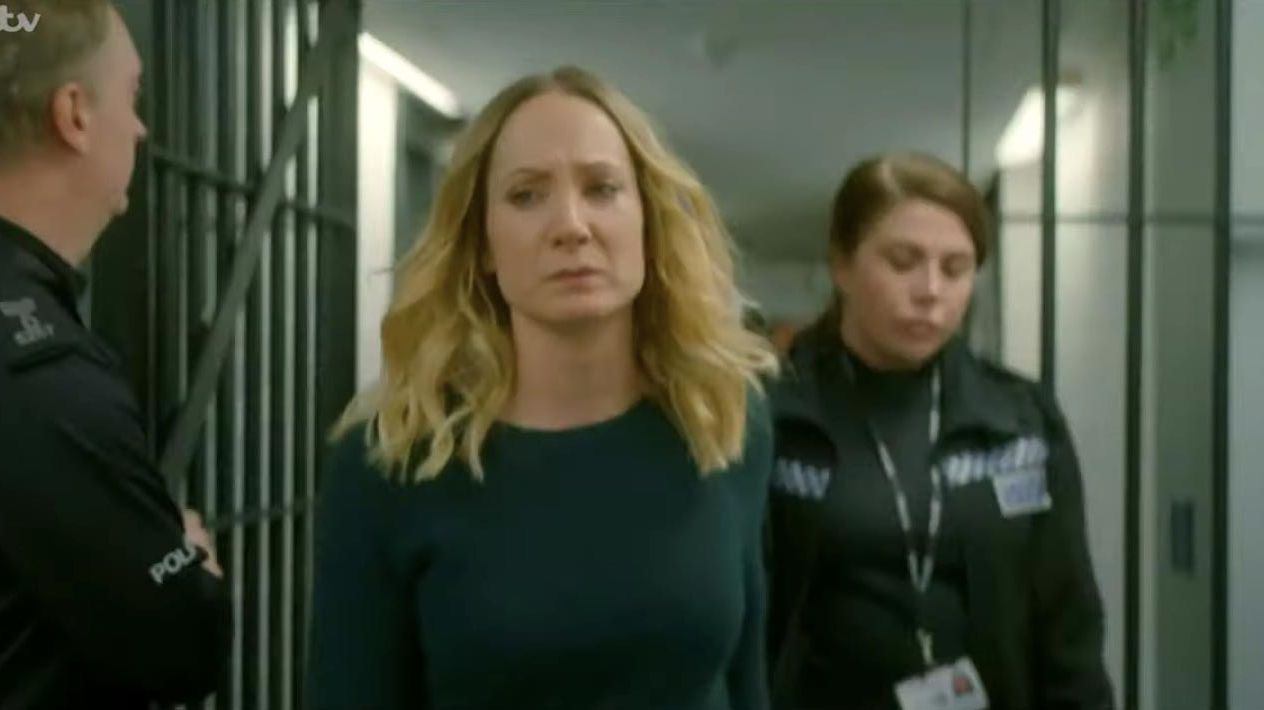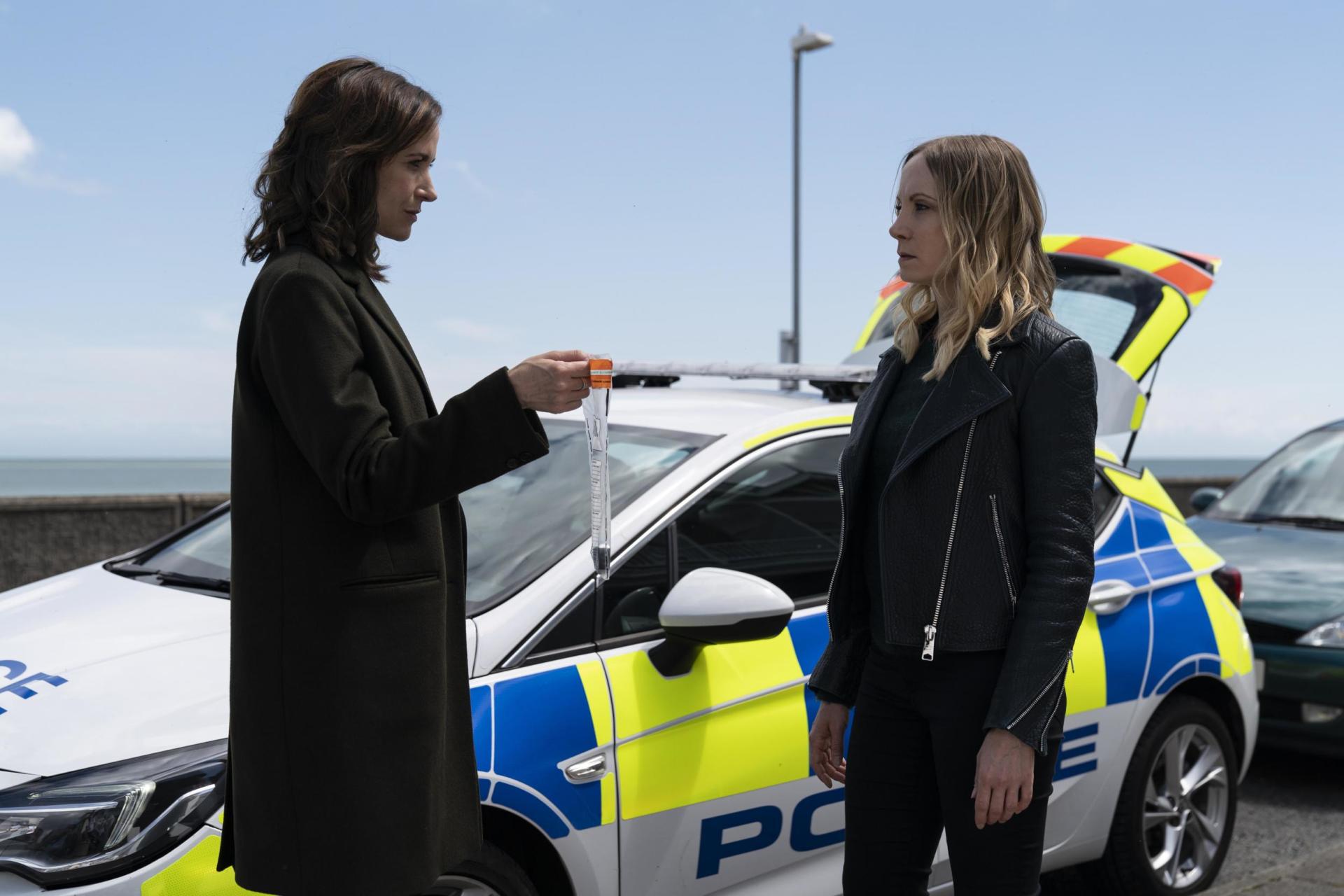TV Review For Authenticity - Liar Series 2

Like most people, I suspect, I tend to save series up and binge watch them over one or two nights. This helps with remembering what happened, who was important and with all the little details that you would forget if you only watched from one week to the next. It also saves you from having to wait a full week before resolving the episode ending cliff hanger. I recall when I was a child watching episodes of Flash Gordon where the hero “Flash” would fall off a cliff supposedly to his imminent death and yet when I returned next week it was revealed he never actually did fall off the cliff and was hanging on the edge and survived. The literal cliff hanger always seemed a cheat to me. I think TV these days cannot afford to be so lazy due to streaming, box sets, catch-up and people like me who save them up.
That brings me on to this review of Liar series 2 which I binge watched over the last couple of nights. I had watched Series 1 in 2017, was it that long ago, and enjoyed the show enough to record and set aside some time, a lot easier to do than normal at the moment obviously, to watch this series. I am not going to comment on the authenticity of Series 1 as to be honest it was a while ago when I watched it and I was taking notes like this time. Before you read any further **SPOILER ALERT**
I will obviously be talking about the show so if you have not seen it and want to in the future do not read beyond this point.
Liar is an ITV production written by Harry and Jack Williams. Starring Joanne Froggatt as Laura Nielson and Ioan Gruffurd as Andrew Earlham. This second series introduced Katherine Kelly as DI Karen Renton.
EPISODE 1
Series Two begins, after a short flashback scene, with the discovery of Andrew Earlham’s body in Kent marshland. We are shown his body being photographed in situ and then removed to a tented area near the scene where a pathologist looks at the body and gives an estimate of time of death and details such as cause of death and weapon type. This is also when we are introduced, although we do not know her at this time, to DI Karen Renton.
Body examined at scene in this manner obviously for dramatic effect
Firstly, I have never known a pathologist attend a scene and conduct an examination in this manner. Why has the body been taken from the murder scene and examined in a tent nearby? There is no evidential advantage in conducting an examination in this way and you are more likely to lose evidence than gain it. The chance of getting a pathologist to the scene in quick time is also very unlikely. The reality is the body would be taken straight to the morgue and a thorough investigation of the body by the way of a forensic post mortem would take place later that same day or more likely the following day at the earliest.
Pathologists are reluctant to give time of death especially when in these circumstances the body has been discovered whilst it is dark and in water. There may be a general opinion but nothing as certain as 6am this morning as was stated here. Obviously, they are trying to tie it up with his watch being damaged. The cause of death would only be preliminary in this case as obviously a full post mortem could reveal other injuries that could have been responsible for him dying before his throat was cut.
DI Karen Renton
The DI is a Metropolitan Police Officer investigating a Kent murder. This would not happen as Kent have their own Major Investigation Team and they would not be happy to have a Met DI come and run their investigation. Unless the body has been found in a deposition location so that there is suspicion that the person was murdered in another area and then moved to where they were discovered the investigating team would be from the area the body was found. In this case that would be Kent. Her explanation was that she was really good and as it was so high profile she volunteered. Utter nonsense this would not happen. If it was that high profile then it would probably be run by a Detective Superintendent but it is more likely in a case like this that a Detective Chief Inspector (DCI) would be in charge or the official term Senior Investigating Officer (SIO) which is the normal rank of officer who leads murder teams. A single DI from a different force investigating a high-profile murder in Kent no chance. I really cannot see why the makers of the show did this? They could have brought in another DI from within a different location in the Kent force or even from Kent’s murder team. Was this simply to imply it’s so serious they had to go to the larger Metropolitan Police for assistance? And this is overlooking the fact that DI Renton was at the scene virtually when the body was discovered. So that means that Kent have realised straight away this is a high-profile murder, contacted the Met for assistance and they have allocated the investigation to the DI who has then got out to the scene, which is on the coast so away from the Met area, whilst it is still in the morning darkness.
DI Renton first enquiry is to speak with their main suspect; Laura. Do I need to mention the fact that DI’s do not go out and do general enquiries in real life? I will just say there will be a blog on what senior ranks do and do not do in real life. Anyway, back to the show and the first thing that the DI does is tell Laura that Andrew had his throat cut. Why would you do this? Why give away such knowledge that you would hope the suspect would make a mistake with by saying something themselves about it in the future? Witnesses or suspects should not get told more than they need to know so they don’t just give it back to you and prevent you from learning anything from them. It is common place for the police to withhold certain vital information from both the public and the family to assist the enquiry.
Suspect Search Warrant
Later in the episode the investigation team decide to search the address of Laura. The DI and DS both attend which would not happen in real life and the search begins. Laura is then seen walking away from the address making a phone call. It is unlikely they would allow her to walk away as they may wish to ask questions to clarify ownership of any potential evidence they discover during the search or they may find something so damning that they must arrest Laura. If the bloody knife was found during the search do you think it would look good if the main suspect has then disappeared as they have let her out of the property? As it is they do find what they believe to be is the car key of the victim’s vehicle. Lucky for them Laura returns to the address and is invited to the police station as they want to speak with her about having the victim’s car key in her premises. This would have to be an arrest as clearly, they now have suspicion that she was involved in his death. How could they justify asking her questions about the keys without her being protected by the rights that an arrest affords? They could not is the answer.
Police Station Interview
The DI and the DS question Laura about the keys being at her address and when they are not happy with her response tell her people would understand after what happened and it is your chance to say what happened, relating to the rape in Series 1. This implies that they suspect she has killed him and yet she has still not been arrested. Dangerous ground for both these officers as clearly going against the Police Codes of Practice and the Police and Evidence Act 1984 (PACE). After this short interview the DI, presumably decides that enough is enough she won’t admit it we will have to go official, arrests Laura and then leads her through to the custody suite where she is processed. These procedures are condensed but a fairly accurate representation of being dealt with in a custody suite.
Custody Time Limits
Whilst in custody Laura phones her ex and asks for his assistance. He informs her it was a while since he practiced but the police can only hold her foe a maximum of 36 hours after which they would have to charge or release her. The actual procedure is after 24 hours they would need to apply to a Superintendent, who if satisfied that the case is being dealt with in the correct manner could grant them a further 12 hours. After this time the police would need to approach the courts with an application for an extension of the custody time limits up to a maximum of 96 hours (4 days). This is called an Application for a Warrant of Further Extension. This is normally done over two separate applications. To satisfy the court the police must:
• His/her detention without charge is necessary to secure or preserve evidence relating to an offence for which the suspect is under arrest or to obtain such evidence by questioning him/her;
• The offence is an indictable one, and;
• The investigation is being conducted diligently and expeditiously
EPISODE 2
This episode begins with DI Renton collecting Laura and her legal advisor, presumably from having a discussion pre-interview, through the investigation office so that Laura could see a file and photo of her boyfriend left open on a desk. The legal advisor states it is a cheap trick and it is, but by showing that someone has previous convictions is she breaching the Data Protection Act and thus committing an offence? Possibly, it is at least something the local Professional Standards (Internal Affairs) Department would be required to review. The three then go on a journey down stairs and back into the custody suite where the interview room is located. What is that all about? Well in reality the lawyer/legal advisor consults with the client, in this case Laura, in the interview room that the interview will take place. In modern stations there have been consultation rooms built separate to interview rooms as these could be occupied by other officers conducting interviews. Whatever is the scenario the consultation with the suspect and her advisor will take place in the custody suite. If it does not there is a security risk of escape or the suspect seeing something they should not. In this case it was built into the scene like this to allow them to introduce Laura seeing the custody image of her boyfriend.
The interview is then conducted by DI Renton and the DS Rory Maxwell, again which would not happen in real life. The quick answer why not is because the people running the enquiry are too busy to spend up to 4 days interviewing the suspect. I will cover this in more detail in another blog as stated.
After the interview Laura is held overnight in custody. Whilst the police have the right to hold anyone in custody, without going to a court to ask for further time beyond 36 hours as already discussed, the reason must be justified it cannot be to let someone “sweat it out” overnight. In a serious enquiry such as murder it is easy to justify holding someone for this length of time as there will be many things going on from waiting for forensic results to checking the account supplied by the suspect in interview.
In this episode Laura is bailed for 4 weeks and the DI leads her out to the press who have been leaked the story. Again, this would incorporate part of the Professional Standards enquiry as it has been used as a tactic to harass the suspect; Laura. Whilst certain tactics can be used to obtain the necessary evidence in a case this would have to be detailed by the SIO in a decision log with their rationale and considerations at this time.
The next police involvement in this episode involves the arrest of Laura’s boyfriend. When he is taken to the station we have a scene where he is being interviewed by the DI and DS and they are discussing the solicitor and the fact that she is delayed due to traffic. For some reason the three of them are in a room discussing the case whilst waiting for a solicitor. This is just made up as if a suspect has requested a solicitor he would wait in the cell until the lawyer arrived the police would not be in a room interviewing someone in this scenario. Just made up for dramatic effect. The DI carries on with the interview without the solicitor being present talking about evidence and what she believes happened. Total nonsense.
EPISODE 3
The first police involvement in this episode is when the DI and DS are interviewing someone in the school where Laura works. I have had enough of saying they would not be doing this so let’s move on and not mention it again. Laura on seeing this interview speaks with the DI. This is not ideal but when DI Renton starts asking her to tell her what happened then this would breach the line of not speaking to someone who is on bail and could constitute an interview I would suspect. This would be another matter to be added to the long list of enquiries for the professional standards department.
DS Rory Maxwell visits the sister who supplies him with a false alibi for Laura. On arrival the DS produced his warrant card and introduced himself as a DI. I presume this was just an error as he is a DS all the other times.
The next scene the police are examining Laura’s car and DI Renton reveals to the DS that she is a previous victim of domestic abuse. This will become relevant at a later stage. The car examination revels a Sat Nav which they decide to download. This reveals the last address Laura went to before Andrew died and they decide to go and see where this was. Whilst this would normally be an enquiry handed to a DC to go and investigate the DI and DS go on blue lights? How is this justified? They take a dog unit and two carriers of police officers. On arrival the dog indicates to a container and they open it to make a discovery of value. What was the dog indicating? Death, blood what? Again, a scene for dramatic effect and not realistic. It’s the cliff hanger to get you back to the next episode.
EPISODE 4
This episode opens with a full forensic scene surrounding the container. The forensic people are in full PPE which is fine, although they are walking around outside the container wearing their masks which is unlikely as they are uncomfortable and people only tend to put them on before going into the scene. We all know about masks these days or soon will on writing this.
This episode does not really involve the police after the initial scene until near the end when Laura is re-arrested for murder outside her home address by DI Renton. The caution is correctly administered and the DS drops in a clue to why she is being arrested. She is then handcuffed and placed in the rear of a police vehicle and driven away. The cliff hanger for the end of this episode.
EPISODE 5
Early in the episode we are back in the interview room with the DI and DS interviewing Laura. During this interview the evidence is produced being a necklace belonging to Laura found in the container and with Andrew’s blood on it. DI Renton states that they have enough to go to the CPS and ask for a charge of murder. At this point the interview would have to be terminated as having sufficient evidence to charge is the point that no further questions can be asked. To be fair the DI only asks one more thing which the solicitor shuts down Laura from answering.
The next scene of relevance is Laura being taken to court to face her first hearing. The result of this hearing is that Laura is given bail. This cannot happen as the first hearing in any case is heard in a Magistrates Court and they do not have sufficient authority to do anything but pass it on to the Crown Court where it must be heard within 48 hours. In other words, she could not have received bail at this hearing.
The Law - The power of magistrates to consider bail in murder cases, whether at first hearing or after a breach of an existing bail condition, is now removed by s. 115(1) of the Coroners and Justice Act 2009. This does not apply to attempted murder or conspiracy to murder.
115 - Bail decisions in murder cases to be made by Crown Court judge
(1) A person charged with murder may not be granted bail except by order of a judge of the Crown Court.
(2) Subsections (3) and (4) apply where a person appears or is brought before a magistrates' court charged with murder.
(3) A judge of the Crown Court must make a decision about bail in respect of the person as soon as reasonably practicable and, in any event, within the period of 48 hours beginning with the day after the day on which the person appears or is brought before the magistrates' court.
(4) The magistrates' court must, if necessary for the purposes of subsection (3), commit the person to custody to be brought before a judge of the Crown Court.
(5) For the purposes of subsections (3) and (4), it is immaterial whether the magistrates' court—
(a) sends the person to the Crown Court for trial, or
(b) adjourns proceedings under section 52(5) of the Crime and Disorder Act 1998 (c. 37) and remands the person.
(6) In this section a reference to a person charged with murder includes a person charged with murder and one or more other offences.
(7) For the purposes of subsection (3), when calculating the period of 48 hours Saturdays, Sundays, Christmas Day, Good Friday and bank holidays are to be excluded.
Moving on do I really need to go over how DI Vanessa Harmon who was also a victim of Andrew and was currently off duty due to her having a baby goes into the police station and uses another officers’ details to find out information about the enquiry which she then passes on to the charged Laura would be illegal? No, I didn’t think so.
Laura then approaches the DS and speaks to him at the gate. He has done nothing wrong and would need to report the meeting as per the guidelines in that force as Laura is on court bail. This would probably lead her to being denied bail at the next hearing as she is interfering with the police investigation.
Laura then continues her enquiries and again speaks with the DS Rory Maxwell in a restaurant. Again, he does nothing wrong but it would have to be reported and be further evidence against her at any future bail hearing. The fact that she steals the DS’s mobile phone during this meeting is not worth mentioning. This leads her to finding out the DS is being blackmailed to protect his son who works for the NCA and had a cocaine drug overdose. She returns the phone to DS Maxwell and speaks to him about the blackmail and believes he has set her up. I suppose if he was protecting his son he could get involved in something and do whatever he could to protect him. Nothing in this scene that could not happen if these circumstances arose.
In this episode DI Renton is informed that her ex-partner has been released from prison and gone back to his old girlfriend who he then killed. This could happen but the scene has been put in to strike a change in her attitude.
EPISODE 6
In this final episode the police are not involved for the initial 12 minutes when DI Harmon helps with having the police involved in arresting Andrew’s fellow sex criminal; Oliver Graham who has been the person to set up Laura and blackmailing DS Maxwell. To do this DI Harmon goes to the police station and speaks with DI Renton. DI Renton warns her that she is on report already prior to speaking about Laura. This leads to the police working with Laura and setting up Graham to expose himself as the blackmailer. This would be tasking a member of the public and involve RIPA authority with regards to phone recordings. All very complex and requiring high level authority. Not impossible but difficult to quickly arrange.
The episode moves on to DI Renton interviewing Oliver about the blackmail, who does not have a legal advisor, which could happen if Oliver did not want one. The DI details the account of what happened via what Andrew’s son told them. She then arrests Oliver for the murder of Andrew and he is led off to the custody suite. Just prior to the arrest he requested a solicitor so these actions would be natural as he would have to wait for the arrival of the solicitor before being interviewed about that matter. The only thing you could say is that clearly DI Renton knew the evidence beforehand and should have arrested Oliver for the murder prior to any interview.
Laura is released from her charge and DI Renton meets her and goes for a walk along the seafront during which she states to Laura that whilst they are charging Oliver with his murder she believes Laura killed him. She explains the evidence and after a conversation states she is stepping off the case as it is done. So, she is saying she is happy for them to convict an innocent man of the murder which goes against her previous behaviour and presumably the change is due to her ex-partner’s behaviour.
Could a conviction of an innocent man in this way occur in real life? Well if the facts / evidence is put to a jury and they convict him then yes it could. Is it likely? I hope not as the evidence of the full case would hopefully show that the person did not kill the victim. Personally, I would like to think that a police officer who knows that a person is innocent, no matter how horrid they are, would not pursue a conviction but obviously I cannot speak for everyone.
A long review of this series if anyone wants to clarify anything about this blog please ask.








